Nothing is scarier than a blackout. Aside from the inevitable death of your cellphone, a grid-down scenario presents challenges to health and safety, especially regarding food.
How do you store the food and keep it cold when your fridge is not working? Thankfully, history provides many valuable lessons.
Should you find yourself without power, there are many easy and accessible ways to keep your food fresh without a refrigerator.
Below we outline our ancestors’ tried and true methods for keeping food cold and discuss strategies that have been updated to fit our modern needs.
25+ Ways To Keep Food Cold Without Electricity
While no one wants to imagine a world without power, blackouts happen often. Although power disruptions usually only last a few hours, there are recent examples of power outages lasting for weeks.
In 2003, for example, there was a widespread power outage throughout the Northeastern and Midwestern United States and most of Ontario, Canada. More recently, in 2013, severe weather left many customers in Quebec, Canada, and some of the United States without power for weeks.
Related: 10 Things You Should Never Do When The Power Goes Out
We take things for granted. The invisible force that powers your lights and runs your fridge is less resilient than you think. Any interruption of electricity from the generation system to your home can cause problems and outages.
Thus, a widespread, long-term power outage is a real possibility, and we must prepare.
Create Or Make Use Of A Root Cellar
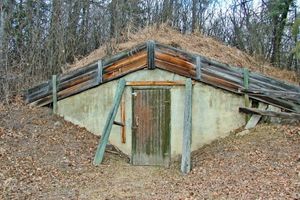 A root cellar is an underground structure that preserves food, keeping it cold while protecting it from frost. A root cellar keeps food cold, fresh, and away from the harmful rays of the sun.
A root cellar is an underground structure that preserves food, keeping it cold while protecting it from frost. A root cellar keeps food cold, fresh, and away from the harmful rays of the sun.
Root cellars can be created within a basement or completely separate from the house.
The main point of root cellars is that they are situated underground where it is dark and cool. If you don’t have a root cellar, here’s a cheap and easy way to build a root cellar in your backyard.
Store Food In A Nearby Cave Or Cavern
Our ancestors would store their daily catch in the deepest, darkest caves they could find. The deeper the cave, the cooler the temperature inside.
Storing food in caves worked well but eventually shifted as humans spread out. With time, people came up with other ways to keep their food cold. Still, many early methods relied on underground areas because they kept food cold.
Create A Natural Spring Box
An alternative method for storing food is to create a natural spring box. A spring box is a small structure built around a natural spring. Natural spring water is cold and, thus, can preserve food.
If you have a natural spring on your property, you can easily construct a spring box and use it to store food in an emergency.
Bury Food In The Ground
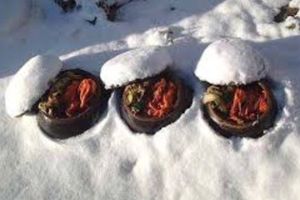 Burying food may seem strange to us in modern times, but it was once common practice. Keeping food buried underground keeps it cold and fresh by removing oxygen, and sunlight.
Burying food may seem strange to us in modern times, but it was once common practice. Keeping food buried underground keeps it cold and fresh by removing oxygen, and sunlight.
Storing food by keeping it buried underground also helps to regulate temperature.
When food is buried, soil acts like insulation and works to retain temperature, cooling stored foods and making them last longer.
Related: What Happens If You Bury A Cabbage Over Winter?
Food burial is still widely practiced in some areas, and has been shown to be effective for food preservation.
If you want to bury food, ensure it is deep enough to retain a cold temperature, and ensure all food is properly stored and sealed.
Hang Food In Wells
Similarly, our ancestors would tie their meals to a rope and hang the food inside a deep water well to keep it cold.
Keep Food In A Nearby Snow Bank
Our early ancestors commonly stored food in an ice cave, glacier, pile of snow, or in a frozen pond or lake.
You can consider yourself lucky if you live in an area with snow. The colder temperatures that create snow provide the perfect environment for food storage.
However, even if you are not in an artic area, many methods exist to safely store food without electricity.
Hang It In A Tree
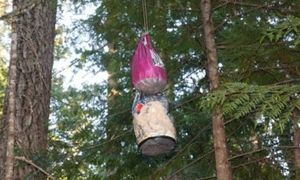 A common practice while camping, hanging your food high up in a tree, out of the reach of animals, is an excellent storage option.
A common practice while camping, hanging your food high up in a tree, out of the reach of animals, is an excellent storage option.
The surrounding air temperature in the trees is lower, and food can be hung for short-term storage.
Wrap Food In A Wet Cloth And Hang It In A Shaded Area
Similarly, wrapping food in a damp cloth or towel and hanging it in a shady spot will help it stay cold.
Store Food In A Nearby Stream Or River
Like a cave or well, rivers and streams will keep food cold. Water is often colder than the surrounding air. Hence, the cooler temperature of the water makes it ideal for food storage.
If you find yourself without power and need to store food in a river, you must ensure the food is safely secured in a tightly sealed container. Furthermore, attaching it to the land is also essential so it is not washed away.
Our predecessors were pretty clever when it came to storing and preserving food. In fact, many of the methods we use today have evolved from earlier practices.
It is essential to have a food storage plan in place for a grid-down situation. Storage is easy to overlook when preparing for a disaster because electricity is part of everyday life.
⇒ Why You Should Never Hide Your Survival Stockpile In Your Basement
Learning from our ancestors’ lessons, here are more tips for storing food without electricity.
Store Food In A Deep Pit Lined With Straw
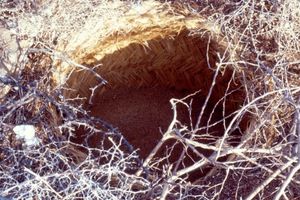 You can store food in a hole to keep it cold as long as the hole is deep enough to be colder than the outside air, is not in direct sunlight, and is covered. The hole can be covered with a tarp, wet towel, or foliage to insulate and keep it cool. Furthermore, lining the cavity with straw adds insulation that retains temperature.
You can store food in a hole to keep it cold as long as the hole is deep enough to be colder than the outside air, is not in direct sunlight, and is covered. The hole can be covered with a tarp, wet towel, or foliage to insulate and keep it cool. Furthermore, lining the cavity with straw adds insulation that retains temperature.
Use An Ice House
People once worked together to store food and keep it cold. Settling in groups, humans constructed local ice houses.
An ice house (a.k.a. ice well or ice pit) was a storage building for ice. However, ice houses could also be used to keep food cold.
Built partially or fully underground, close to a natural water source, each community had an ice house. The ice house would store snow and ice insulated with straw and used to preserve food.
Sadly, few ice houses remain, but thanks to technology, you can get instructions online and create one of your own.
The internet is one of man’s greatest inventions, and it holds a plethora of information that can teach you how to construct valuable objects.
Use A Fire Pit
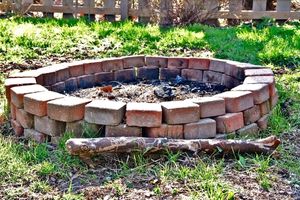 Yes, a fire pit can help you store food without power. You can use a fire pit to create a natural cooler. A fire pit that is lined with stones provides natural insulation.
Yes, a fire pit can help you store food without power. You can use a fire pit to create a natural cooler. A fire pit that is lined with stones provides natural insulation.
Fill the stone-lined hole with cold water, and use this space to store food in sealed containers.
Related: How To Dig A Native American Dakota Fire Hole
The hole, water, and stones create refrigeration and will remain cool even on a hot summer day. Be sure to cover the hole to block out sunlight.
As you can see, there are many ways to store food outdoors. In fact, minor changes to these suggestions can create even more options. For example, you can store food in a wagon or a shaded outdoor storage area. However, covering it with a damp towel will help it stay colder longer.
There are also ways to store food that you want to keep warm. A hay box, for example, is like a cooler lined with hay. The hay acts as insulation, keeping the contents warm and toasty.
There are so many ideas for storing food without power.
Here are a few more:
- Wrap food in newspaper and place it in a covered box with ice or ice packs. Dampening the newspaper will also help regulate the temperature.
- Store food in a well-ventilated room or closet with a damp cloth over it.
- Keep food in a wooden crate or box with a wet burlap sack.
Off-grid storage is possible, practical, and easy to implement in an emergency if you are prepared.
Should you find yourself in a position where you need to store food without electricity, here are more tips that may help.
Material Matters
The material you choose when storing food matters as much as the method. Some materials retain temperature better than others.
For example, metal and clay keep food cold by retaining temperature, and so does styrofoam. You can purchase various cooling containers online.
The Magic Of Evaporation
Evaporation keeps food cold. In fact, evaporative coolers have been used for centuries.
You can harness this power to keep food fresh by creating an evaporative cooler at home or buying a similar object online.
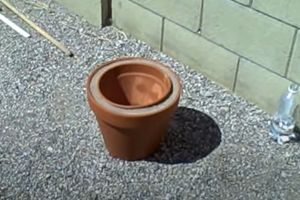 The zeer pot is an example. A zeer pot and similar items consist of two clay pots, one larger than the other.
The zeer pot is an example. A zeer pot and similar items consist of two clay pots, one larger than the other.
The internal clay pot is unglazed, and wet sand is packed between the two items. The porous clay allows evaporation to escape, cooling the internal contents.
This gadget is highly effective and is widely popular around the world. You can create a zeer pot or similar device to keep food cold. Alternatively, a clay pot in the fridge works the same way.
Embracing Modernism
While the ingenuity of our ancestors is impressive, we have come a long way and now have access to many items and materials that did not exist in earlier times. Thanks to time and evolution, we have many more ways to store food and keep it cold, even without electricity.
Use a cooler with ice: While it may not be a long-term storage solution, using a commercial cooler to safely store food and keep it fresh is pretty simple.
Use a traditional icebox or ice chest: An icebox is essentially a wooden cooler or fridge lined to create insulation and packed with ice to keep food cold,
Freeze water to store food: You can pack ice or frozen water bottles around food to keep it cold while the power is out.
Solar-powered fridges or coolers: Advancements in technology have allowed us to create many incredible inventions. One of these is the solar-powered fridges and coolers that are widely popular today.
A solar-powered cooler will harness sunlight and convert it to DC power, fueling the system and keeping the contents cold.
Propane-powered cooler systems: Similar to solar-powered systems, propane-powered cooling systems find alternative fuel that helps to keep food cold. These systems can be purchased online and are carefully constructed for safety and efficiency.
Insulated Thermos: While this is not a new or profound invention, the insulated thermos can be used in an emergency to keep food hot or cold. I suggest having a few different sizes available in case of an emergency.
Fears of a large, long-term power outage are justified, and preparing for such an event is essential. Having a stockpile is useless if you are not considering storage. Be sure to cover all your bases and be prepared should the power go out.
I would love to hear what you would add to this list. Share your ideas in the comments.
You may also like:
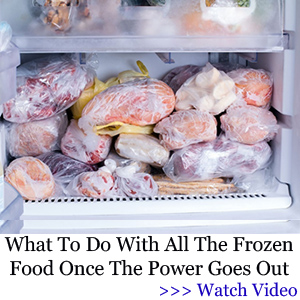 The Only Supplements You Need To Stockpile For A Crisis
The Only Supplements You Need To Stockpile For A Crisis
70+ Ingenious Projects To Survive A World Without Electricity (Video)
Lost Survival Lessons from the 18th Century Pirates Who Ruled the Atlantic
10 Household Items You Need To Stock Up On Before The Upcoming Great Depression

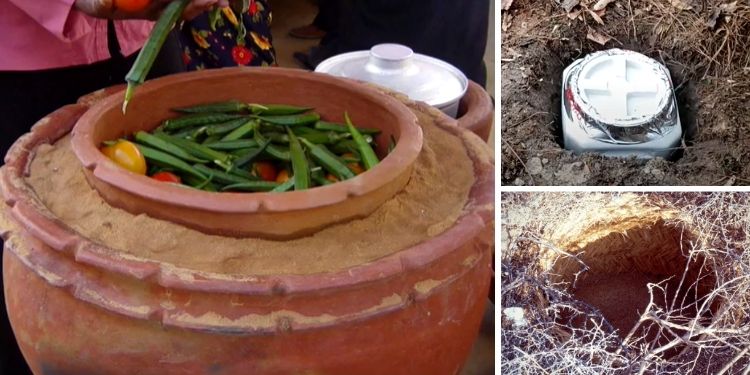




















These are good suggestions to start or add to the preps. One size fits all does not work for all. We need to adapt to our locations to fit in our lifestyles. The upcoming govt interference with AI will start to control access and our finances to how we can react. The banking system maybe on the collapse to a fed digital coin.
So now is the time to brush up on our skills and tools for the new self induced collapse of our system by incompetent officials. The lost ways books will come in handy for reference. And other skills we should re-evaluate in these trying times.
We can’t depend on the white knight politician to say the day for us.
As said before you fight the war with what you brought to the situation. No one is 100% prepared. We can assume we have all the bases covered in the short term outlook.
Eventually we will need to restock certain things but if the total supply chain collapses. And we have depended on the Chinese CCP for food & drug manufacturing base for a major foundation. Will there be small Mom & Pop business manufacturer’s to fill the gap?
What do preppers really prep for? What is our preps and supplies time line prepared for? Where will the resupply points be at? Eventually some type of governing body will resume. But as we see Hollyweed’s doom & gloom movies like the postman and Mad Max kind of portray. Are we willing to survive that way?
Depending on our age & health, will we have the physical stamina to tend a garden? Our food supply will change, crop failure – weather, looters, animals can take a toll. The rodents have been fighting in normal times in the garden. What stress will that be when SHTF when we don’t have the convenience of the local grocery store as backup?
Yes I believe in independence but eventually we will need to interact with the general public for our short comings. No not saying it’s a bust. But thinking clothes will eventually need replacing too. Most of us don’t make clothes to wear.
Just some brainstorming things will need to ponder on before SHTF for real. Our Grandparents went through the great depression, some kept their heads strong will we do the same?
Yes, clothes will need to be eventually replaced too. Fortunately, clothing is the easiest and cheapest thing in a preppers arsenal to acquire and store. Used clothing for very little cost is readily available from about 5 places in my area. Having said that, and along the lines of this concern, i bought a couple packs of socks the other day just for this very reason. I put them away for later usage if needed. Yes, i can clumsily sew and patch a sock or other garment, but time is worth something when you are living w/o power in an SHTF situation. I’ve bought several items that are relatively inexpensive and store well. Toothpaste, toothbrushes, deodorant, several cleaners and soaps, matches, etc. Not cases of them, just 2-4 extra at grocery time. I know enough to know that i’m not even close to fully prepped for an EMP event, but could go several months out in the brush as long as i can secure a water supply. I can hook up a generator to power my well pump, but it runs on gasoline, and that doesn’t store well and is kinda expensive to buy a bunch of. Gasoline isn’t somthing that a “good ol boy” can make in his garage. Yes, i could go diesel and be able to fabricate biodiesel w/o too much trouble, but i’ll let ya in on a lil secret. Biodiesel, with all of it’s ease of fabrication, has some serious drawbacks. It doesn’t store well unless certain additives are present in it. It’s lubricity isn’t near what pump diesel is and those 2 factors cause enormous problems in diesel fuel systems. I know people that have made the jump to biodiesel in their vehicles. Fuel pump and injector issues follow in a few thousand miles. Doesn’t it seem strange that countries around the world don’t use biodiesel in any serious quantity? The tolerances inside high pressure injection pumps and injectors is measured in ten thousands of an inch. Biodiesel Does Not work in the long run and causes some very expensive damage along the way. So that doesn’t help me in my choice of generator. Although it does store much better than gas does. EMP Commission estimates that power will be down from 3-10 YEARS! There won’t BE any resupply for gas, diesel, propane, etc. Not for years and the price will skyrocket if it is available. Here’s a test that ALL preppers need to consider being able to pass. If you feel fairly well prepped, try this simple test and see how you do. Go to your breaker box and flip off the main breaker. Keep track of what happens next and what items you wish you’d had on hand. Betting the VAST majority will flip that breaker back on in under a week. Just some food for thought.
I agree with the article methods of food storage. Storing food in the snow is good short term. Depending on location the ground soil with clay and rocks might not be applicable. To dig or material to build a ground root structure. As we transition into other climate seasons, after the snow.
Some elderly may not be able to build root cellar structures for the warmer seasons.
The article has good short periods ideas to keep food from spoiling.
What have other blog readers done for longer term food storage? Has anyone really tried these methods? How long did the food last before it was spoiled?
Some methods are good for a stable situation as in home, bug-in. The question is if we bugout some of those things like a Zeer Pot might not be taken and depending on the bulk of the food a large portion will be left behind in a bugout.
Think it will come down to how physically fit we are to take our possessions with us. Are we using these method for ling term or short term use?
Many of us live near the cities, suburban type locations. City living with these methods will be a hit and miss effort with constant guarding from looters, opportunist.
The mid-range to rural settings will make better use of these methods.
Is the rural to outdoors a be all to freedom or a nightmare for using these methods? Will we also have to be on the guard for the opportunist who did not prepare out there?
I blame myself for being semi-prepared and those dumb-down political voters, who voted us into these dark times. As in the old saying of insanity, voting for the same one-party system expecting a different result is nuts.
As we age we can do these methods, but will need adapting. But defending our choice of prepping will be strenuous. Are we actually looking at America rapidly dying the 200 year death? As we have Europe years ago die from the illegal influx of the middle yeast. Is this the same thing happening here in America with the open Southern Border?
How long until we collapse? We have illegal consuming the American Dream of the free lunch. And our own Woke Snowflakes aren’t any better in attitudes either, free college.
If America is such a racist country, then why are these illegals coming to America?
Well guess this food storage methods may give us some hope. Without food and water we will be a hurting unit. As these free-lunch-ers consume our stored govt supplies tagged for us citizens.
Are we prepping for the wrong reasons of self sufficiency or what?
Sadly, in the case of an EMP attack, we’ll be devastated. The EMP Commission did a study with several different groups independently gathering information as to the results of such an attack on the civilian population. To cut to the end, between 84 and 92% of the population die within a year or it might have been 18 months. I couldn’t believe the numbers were so high until i dug deeper. It’s starvation and violence from that wipe most of us out. Try this. Walk outside your home or apartment to the front yard, parking lot, etc. Stand there. Take a deep breath and look around. If you had, no car, no $, no home, or no home with food in it and no store to go to buy or even steal food, what would you do. Banks are down, cards don’t work phones don’t work, people are looting everywhere just trying to grab some food. Lets just say you have a running vehicle with a full tank of gas. What would your destination be? Densely populated urban areas will be a nightmare in just a few days. If you have an uncle, cousin, parent, etc that lives way out in the country and you show up there will you be welcomed? Do you have a useful skillset? Can you sew, bake, hunt, fix machinery, build a house from logs, tend a garden well? Food for thought. And if you’re vehicle doesn’t start after an EMP attack, what then? One easy answer to that question is get a module that would protect your vehicles electronics. empshield.com About $400, sometimes they have coupons that cut them down to around $350. Easy to install, only 3 wires. So after an EMP attack you’ll see some vehicles, mostly government ones, driving just fine. That’s why. Go to that website and check them out. They also have a very large library of free downloadable EMP reports, etc. Tons of good data. Stick one of those on your vehicle and forget about vehicle preps like buying an older whatever and try to buy enough spare parts to have on hand to slap on right quick after the EMP damage. Buy the module and drive what ya got. Don’t get me wrong though, a good AWD or 4WD bugout vehicle is nice to have in your back pocket for sure. To be absolutely SURE you have an old enough vehicle to be EMP proof, you’ve got to be pre 1972. Period. No if’s and’s or buts about it. Point ignition or non electronic diesel. Prior to 72 most all alternator voltage regulators are mechanical with guts like a relay. Those vehicles do still exist, but are is pretty much 2 conditions, restored/very good condition which means expensive or just about junk and likely not even complete. You can still find some fixable older vehicles for not too much, but it’s still a lot of time and effort, not to mention $ to fix those up. Put a Module on what you have and keep yer mouth shut about it. Get out of the city. Go to uncle Bob’s with every bit of food, tools, guns and ammo you have. Pack the loved ones in and hit the highway quick. Keep firmly in mind that you’re running vehicle WILL make you a target for those that would take it from you.
In the south, other than winter, it will be a challenge. I’ve had power outages lasting over a week in the past 25 years. First and foremost. Don’t open your standalone freezer. they are insulated and even without power can keep your food frozen for several days and cold for several more.
If you have a generator or a way to connect to your car/batter for an hour, you only need to run a freezer for about 1 hour out of every 8.
Obviously not a long term solution, but good for short term emergencies. Fortunately for most of hours we have plenty of warning that a storm is heading our way.
In Cali the Greenies are forcing laws to make a minimum 30k retrofit from everything gas stoves to electric stoves. They can’t even keep electricity going without rolling blackouts. And those dumb EV’s can’t always charge up with brownouts happening.
So it depends on where we live depends on how we adapt these food storage methods. No wonder commonsense people are leaving Cali there:(
Cali was a golden State, now it is a brown (poop) State spreading their Marxism to other States. The State is fantastic, it’s the crap politics, woke-ness that sucks.
I like (not really) the crazies in Kali-fornication, the unions and environmentalist’s who ruined the food chain supply. By re-routing the Fresno Farmers major portion of irrigation water diverted to the ocean. Because their excuse is for not having the fake Delta Smelt endangered fish from getting squished in the irrigation water pumps to the farm fields.
This is the craziness the current CA governor wants to spread across America as a president. That is what a Blue Sanctuary State does to the food supply.
These activist and environmentalist don’t want us to do these food storage methods to save ourselves in the coming days, if we let them rule.
What this article does is to get us through the short term until we can find long term methods.
As said it depends on our location, weather seasons and what we have available to use these these methods. We are on our own in some areas of the country. Hopefully in our time of need we can link up with like-minded people.
Keep the prep articles coming they can inspire us through the difficult times ahead!
The reason they want everyone to convert to elec. is that a gas stove can be used when the power is out and they do not want you to be ale to do that!! They want to depopulate the world and this is one way of doing it!! I was born and raised in Ca. and would love to move back but will not because of the way it is being governed! I moved out 18 yr.s ago and live in a Rep. state but the winters are terrible but one good thing about it is I use my porch and garage to keep a lot of food frozen! One day I pray that the Lord will let me go home again! Or best of all go home to be with Him!! Pat
when I was in the boy scouts, in Maine, back in the 70s we would use an old apple crate or milk crate weighed down with a few bricks and set it in the creek. it would keep our dairy and some meats cold enough to last the weekend in the woods just fine.
Just wish i had a creek handy…….
Hi Pat M., Cali back about the 1970’s was still governed by a 2-party system. Now we have Marxist educated dopes who probably never had a back braking job in their lives. To compare with, as they demand high wages for a entry level job. That leads to a higher paying job by experience. They want to skip a couple rugs up the ladder of success, the snowflake way.
Those weak-minded will fall when the SHTF, no hope to learn basic skills like how to keep food fresh to consume. There is no free lunch, someone always pays for it.
Like the great articles that are posted. We can agree to disagree on some ideas. Depending on the level of life experiences we done in prepping and plain commonsense that is lacking today. And still learn something new from others who tried these projects.
Yep, that’s the TANSTAFFL principle yer talkin about. Term coined decades ago. There Ain’t No Such Thing As A Free Lunch.
Few of these ideas, are actually effective in the Desert Southwest. Anticipating at 72 I will likely have to bug out in place … There are no springs, wells, streams. The ground is hard, a mixture of Rock and a clay similar to concrete … so digging any kind of hole … deep enough to keep items cool are a bit of a problem. Water lines into my home are buried about a foot below the surface, and during the summer, the water out of the spout is hot enough to bypass the water heater and get a satisfying hot shower. The suggested easy to build root cellar, I am fascinated by the idea, but the video merely promotes the book, and I’m not purchasing another book, without seeing that it is possible in the desert with hand tools.
In my area of Missouri a digging a root cellar is readily doable. As long as you want a small one and have jackhammers, sledgehammers, pry bars, shovels, wheelbarrow, pick, mattox, etc. Better yet a piece of equipment like a hoe, dozer or best of all a backhoe. And not small pieces of equipment, large as yo can find, rent, borrow, etc. Long time back they used explosives to carve out a basement around here. Still do in big commercial jobs. This isn’t Iowa. There is NO dirt with rocks in it here. There’s only rocks with a lil bit of occasional dirt between, lol.
richard williams i am in webster county and i agree with you on digging in the ground. i till up rocks in the garden yearly the size of my head. thankyou for the info on empshield.com i am going to look into this.
Get an old Fridge and bury it.
if your ground is HARD, use water, keep it wet, dig a little and keep adding water to loosen it.
you dont have to start and finish in the same season, let alone same day.
HIRE heavy equipment. dig center to depth, and dig a shallow area around the top of your center, build a roof down in the upper area and hide it – as its below ground level even a few inches thats easy ( even if its just by adding back some dirt).
@bobmarshal:
problem here is water table: can’t dig because you run into water…..my well is only 52 feet down…..Now I know that I won’t need to dig that much to make a root cellar, but the water is above that to a degree, and moisture is NOT good for a root cellar. So…..I’m stuck.
ice house
dont forget, water is easier to carry than ice. with some plastic sheet and home made forms, you can freeze the blocks at or in your ice house. spot heat to remove the form and make another.
having half a dozen freezing at the same time will cut down the time to fill your stock pile. larger blocks melt slower. 4″ thick 4′ x 8′ foam sheets, dirt, hay, etc will insulate it well. make it not much bigger than the ice you need, as the more free air, the faster it melts.
watching tv shows about the frozen remote areas, will give you many ideas, but I cant figure out why the wear and tear in man and precious machine, when they could pump water and let it freeze. dont forget, animals dig well. a steel container, locked in the ice house will lessen the effect of an intrusion. 55 gsl drum with clamp on lid works well, even in a direct burry usage. if your in the desert, please dont complain about little cold and lots of heat. you have that problem and we must cut a hundred trees to keep warm. its they guys in kentucky, with cold water flowing every where, not too hot, not to cold, food walking by, well lets just say if you ever called them dumb hillbillys, jokes on you.
Can you recommend a prep food supplier that is less expensive than others?
An answer is appreciated…. Steve
Most of the suggestions here will work GREAT……. in the winter. But NOT in the summer. Heck, sometimes because my fridge gets full, I leave vegetables outside on my porch in winter, but to do it in summer….dead, rotten veggies!
And while the suggestions toward the end are nice, coolers and ice chests (block ice takes up space) won’t hold much, especially the solar or otherwise powered ones…they are TINY.
The other issue I have is many ideas are for outside and you need to be prepared for looters but also wild ANIMALS that will be lured by smell to your location and my be more interested in the FRESH meat: YOU.
So, for very short term, these might be good, but for long term and for someone who has large freezers full of meat and things, not so great…
Not sure there is really any good answer.